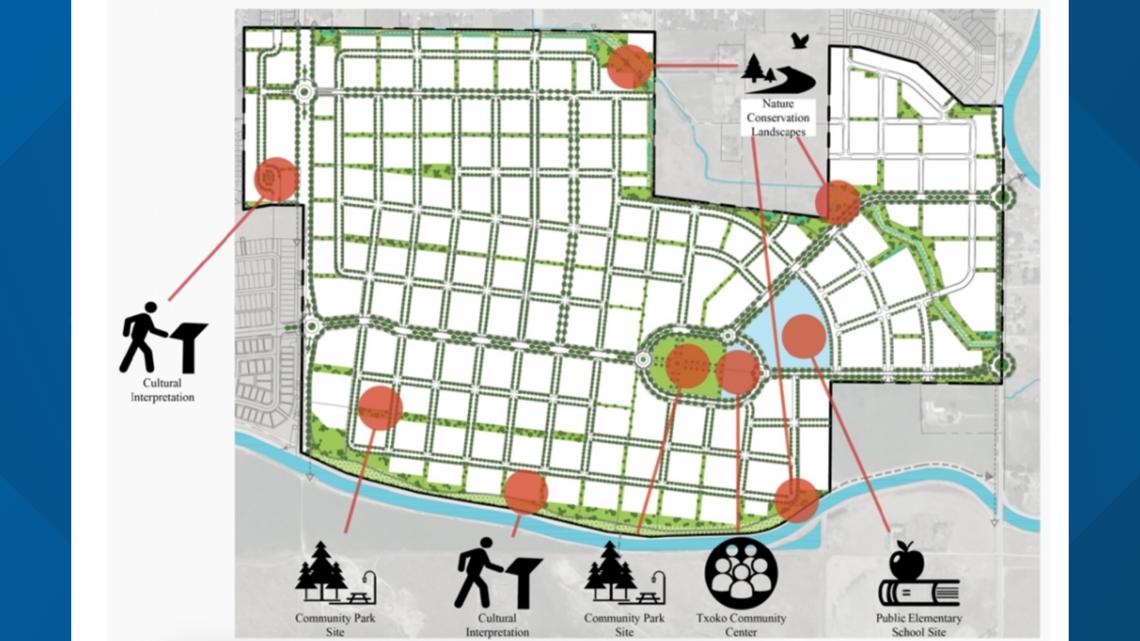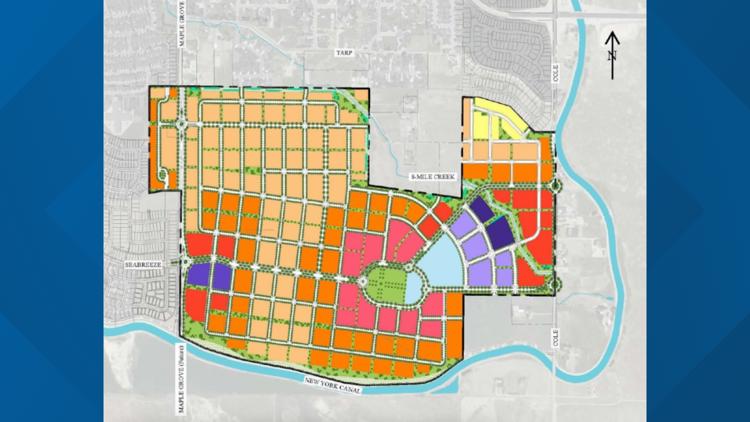BOISE, Idaho — This article originally appeared in the Idaho Press.
Boise City Council approved the Murio Farms Development in a contested decision Tuesday.
The southwest Boise development will bring more than 3,500 homes to the area with 94,000 square feet dedicated to commercial space. The development — located along the New York Canal, east of Maple Grove Road and west of Cole Road — will have a variety of housing arrangement for renters and buyers, including single-family homes, attached single-family homes like duplexes and multi-family housing such as apartments. A public school and a number of parks and green spaces in the community are also slated to arrive as part of the development’s plan. The project is scheduled to be constructed through a multi-phase plan spanning 20 years.
Boise City Council’s decision approved the annexation of the development’s land, which will incorporate what was previously unincorporated Ada County into the city limits.
After formulating multiple analyses of the development over the summer, Boise’s planning departments remained skeptical of its ability to be financially viable.
The city’s finance staff concluded that “annexation is hard to justify financially” following the Idaho Legislature passing a 10% reduction in property taxes statewide that has been compounded by rising costs from when the development was initially modeled in 2021, Mike Sherack, Boise’s senior budget analyst, said.
Citing the losses expected with the development — which Sherack said would lessen the city’s ability to make investments into servicing and developing existing parts of the city — the city’s planning team and the Planning and Zoning Commission recommended denial of the annexation Tuesday.
In a cost analysis presented by Deb Nelson of Givens Pursley Law Firm, Murio Farms contended that differences in assumed home values and construction growth rates would allow for the development to be net positive financially, with a surplus of $8.7 million projected over 20 years and $12.4 million projected over 30 years.
The development also expects to contribute over $19 million in impact fees to the city to cover police, fire and parks services for the area. To address expected traffic increases, Murio Farms will be contributing $10 million in impact fees to the Ada County Highway District.
The impacted public service representatives who spoke Tuesday were divided in their support for the development.
VALLEY REGIONAL TRANSIT OFFERS SUPPORT
In the Tuesday meeting, Valley Regional Transit expressed excitement at the prospect of Murio Farms providing funds to VRT as part of the ongoing development of the area, with hopes that the move could serve as a model for future developments that could similarly contribute to VRT’s financial base. Under the proposed agreement between VRT and Murio Farms, VRT would receive $50 per housing unit as a one-time fee and $25 per housing unit each year ongoing.
“What we were excited about with this particular application is the opportunity to bring additional funds that aren’t general funds from our local jurisdictions to the table so that we could look for ways to defray the costs of transit services to the communities that we’re serving,” Stephen Hunt, VRT’s chief development officer, said.
POLICE DEPARTMENT UNCERTAINTIES
While allocations have been made to fund additional police personnel in the area, the Murio Farms property — lying between areas patrolled by the Boise Police Department and the Ada County Sheriff’s Office — did not yet have procedure in place for responding to the needs of the development, Tammany Brooks, BPD’s deputy police chief, said.
Assuming personnel needs are satisfied, an agreement between the two departments will still need to be forged in order to have a plan of action for the area, Brooks said.
FIRE DEPARTMENT CONCERNS
Boise Fire Chief Mark Niemeyer expressed ongoing concerns about the ability of the Boise Fire Department to provide timely emergency service to the Murio Farms development. Station 17 — located on Cole Road — would be tasked with servicing the area, a station Niemeyer said is already “burdened” and would be unable to meet the department’s target response time of five minutes.
“Without a new fire station in the area, we’re going to continue to put that burden on a station that’s already burdened,” Niemeyer said.
While Niemeyer acknowledged that the Whitney Fire District has plans to build a station at Lake Hazel and Orchard that would be able to serve the residents in the area, there are outstanding concerns about raising the revenue needed for the future station’s personnel needs, Niemeyer said.
The Whitney Fire District covers about 18 square miles in south Boise, serving approximately 21,500 people, according to its website.
“To build a station is one thing, to staff the station is completely different,” Niemeyer said. “And right now I don’t think Whitney (Fire District) is in a position to staff that.”
CITY COUNCIL RULING
City council ultimately approved the property’s annexation in a 4-2 vote after previously delaying a decision on the property in May of this year.


“I wish there were less risks associated with bringing this on,” Colin Nash, city council president, said. “I can’t mitigate all of that risk ongoing, but I can give us the best shot to absorb that risk over a 30-year period.”
To mitigate this risk, a variety of stipulations were placed on the approval of the annexation. Under the council’s decision, Murio Farms will be required to provide $4.5 million using mitigation fees that will be levied on each housing unit. This dollar amount stems from the planning department’s June analysis of the development that projected a deficit of $4.5 million after 30 years, assuming annual property tax growth of 3%.
These fees will be collected in addition to the aforementioned impact fees the development will already be contributing to the city and ACHD. An additional $2 million in fees will be levied to support the proposed Orchard Street realignment project, that would look to create a major thoroughfare in southwest Boise.
Stipulations were also made with respect to city services. To address concerns of the Boise Fire Department, building limitations will be implemented until a new fire station is constructed in south Boise. Under the plan, no building permits will be issued after the first 556 homes or until the fourth phase of the project is complete, whichever is first.
The development will also be required to develop a transit development management plan in advance of the initial development phase. The development will work alongside VRT to provide funding for stops and transit routes to the area.
A 7-acre elementary school site for the West Ada School District will also be required as part of the plan. All park areas will also be dedicated to and developed by the city of Boise using funds the development will allocate for the city’s park services. Murio Farms will also be given the option between dedicating 3% of every 500 housing units for residents making 60% or less of the city’s median income, or allocating 4 acres or more of the development property for city use.
The council’s supporters of the development pointed to Boise’s ongoing housing needs as the impetus of their decision. Council member Luci Wilits argued that if the development were denied, the “city will be complicit to driving folks out of Boise and the congestion will get worse” for those commuting into the city.
Council member Kathy Corless voiced similar concerns after initially deciding to reject the project. She noted that the development would help address the city’s “housing crisis” and that the additional fees levied on the development would allow for a new fire station to be budgeted for the service area.
The decision’s two detractors voiced concerns about how the development would stretch the city’s resources. Council member Jimmy Halliburton described the annexation as “financially irresponsible,” noting that it will take city resources away from already built-out areas. Council member Meredith Stead said the project went against what she considered “smart growth” — developing where existing infrastructure is already able to support new projects.
“We have residents in current neighborhoods waiting for pathways, bus stops, bike lanes, libraries, for neighborhood and roadway improvements and for our firefighters who are waiting on four-person teams city-wide,” Stead said. “I predict these priorities will be at the bottom of the list as our resources pivot to support this development for the next couple or more decades.”
This article originally appeared in the Idaho Press, read more on IdahoPress.com.



